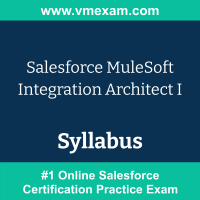 The Salesforce MuleSoft Integration Architect I exam preparation guide is designed to provide candidates with necessary information about the MuleSoft Integration Architect I exam. It includes exam summary, sample questions, practice test, objectives and ways to interpret the exam objectives to enable candidates to assess the types of questions-answers that may be asked during the Salesforce Certified MuleSoft Integration Architect I exam.
The Salesforce MuleSoft Integration Architect I exam preparation guide is designed to provide candidates with necessary information about the MuleSoft Integration Architect I exam. It includes exam summary, sample questions, practice test, objectives and ways to interpret the exam objectives to enable candidates to assess the types of questions-answers that may be asked during the Salesforce Certified MuleSoft Integration Architect I exam.
It is recommended for all the candidates to refer the MuleSoft Integration Architect I objectives and sample questions provided in this preparation guide. The Salesforce MuleSoft Integration Architect I certification is mainly targeted to the candidates who want to build their career in Salesforce Architect domain and demonstrate their expertise. We suggest you to use practice exam listed in this cert guide to get used to with exam environment and identify the knowledge areas where you need more work prior to taking the actual Salesforce MuleSoft Integration Architect I exam.
Salesforce MuleSoft Integration Architect I Exam Summary:
|
Exam Name
|
Salesforce MuleSoft Integration Architect I |
| Exam Code | MuleSoft Integration Architect I |
| Exam Price |
Registration fee: USD 400 Retake fee: USD 200 |
| Duration | 120 minutes |
| Number of Questions | 60 |
| Passing Score | 70% |
| Recommended Training / Books | Anypoint Platform Architecture: Integration Solutions (ARC730) |
| Schedule Exam | Kryterion Webassessor |
| Sample Questions | Salesforce MuleSoft Integration Architect I Sample Questions |
| Recommended Practice | Salesforce Certified MuleSoft Integration Architect I Practice Test |
Salesforce MuleSoft Integration Architect I Syllabus:
| Section | Objectives | Weight |
|---|---|---|
| Initiating integration solutions on the Anypoint Platform |
- Differentiate between functional and non-functional requirements for integration solutions. - Select features of Anypoint Platform for designing and managing web and event-driven application programming interfaces (APIs). - Select deployment options of the Anypoint Platform control plane and runtime plane. |
8% |
| Designing for the runtime plane technology architecture |
- Analyze the mode of operation of a Mule runtime cluster that differentiates it from other deployment options. - Design integration solutions deployed to CloudHub to address specific requirements using CloudHub's network features. - Choose Mule runtime domains and domain-shared configuration only for those requirements that clearly benefit from their capabilities. - Design Mule applications making effective use of the implications of the Mule 4 class loader isolation of Mule modules. - Describe the characteristics and implications of the Mule 4 reactive event processing model. |
15% |
| Designing architecture using integration paradigms |
- Create high-level integration architectures using API-led Connectivity. - Create high-level integration architectures using web APIs and HTTP. - Create high-level integration architectures using event-driven APIs and message brokers. - Design Mule applications and integration solutions using common messaging patterns and technologies. |
10% |
| Designing and developing Mule applications |
- Select among available options for setting Mule application properties. - Select and use fundamental features available to all Mule applications. - Design Mule applications using core routers available to all Mule applications. - Describe the fundamental features of the Salesforce Connector. - Design Mule applications using common features of core connectors. - Select and use the available sources of metadata in the Transform Message component. - Design Mule applications and integration solutions using a Common/Canonical Data Model. - Correctly apply methods for validating data in Mule applications. |
15% |
| Designing automated tests for Mule applications |
- Design unit test suites using MUnit and Studio's related features. - Identify test requirements and scenarios that are best addressed using integration testing or performance testing. |
5% |
| Designing integration solutions to meet persistence requirements |
- Design Mule applications using Virtual Machine (VM) queues and the Anypoint VM Connector in all deployment options. - Design Mule applications using Object Stores (OSs), the OS Connector, and OS services in all deployment options. - Design Mule applications and integration solutions using stateful components that may be configured with an OS. |
10% |
| Designing integration solutions to meet reliability requirements |
- Select alternatives to traditional transactions (local or XA) where appropriate and beneficial. - Recognize the purpose and characteristics of Until Successful scope, reconnection strategies, and redelivery policies. - Differentiate between disaster recovery and high availability and the basic approaches to achieving either in all deployment options. - Design Mule applications and integration solutions using local and XA transactions for all Mule connectors that support them. |
8% |
| Designing integration solutions to meet performance requirements |
- Design Mule applications and integration solutions to meet performance and capacity goals. - Design Mule applications using available streaming features in Mule. - Design Mule applications to process large sequences/streams of messages. |
7% |
| Designing integration solutions to meet security requirements |
- Design secure access to the Anypoint Platform control plane and APIs. - Design secure edge access using Anypoint Security. - Analyze and counteract potential security vulnerabilities of Mule applications. - Recognize the audit logging capabilities of Anypoint Platform. |
8% |
| Applying DevOps practices and operating integration solutions |
- Create the high-level design of continuous integration (CI) and continuous delivery (CD) pipelines for Mule applications using MuleSoft-provided Maven plugins. - Identify the features and characteristics for automating interactions with Anypoint Platform. - Design the logging configurations and options of Mule applications in all deployment options. - Identify the features and characteristics of Anypoint Monitoring in all deployment options. |
14% |
